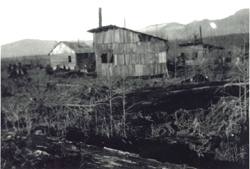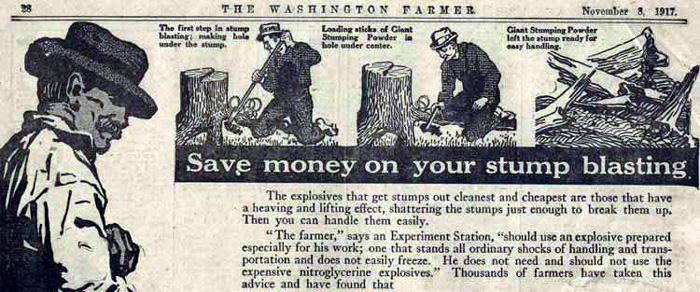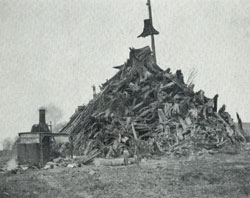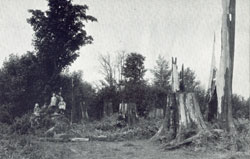 "There is one remarkable thing about starting from scratch on a stump ranch, and that is everything that one accomplishes is done by hard work, and when it is done there is a sense of elation and thankfulness, where there is so many things to be done; each task accomplished, results in a sense of pride.
"There is one remarkable thing about starting from scratch on a stump ranch, and that is everything that one accomplishes is done by hard work, and when it is done there is a sense of elation and thankfulness, where there is so many things to be done; each task accomplished, results in a sense of pride.Now and then a few dollars was spared for some dymamite to blow some of the stumps, especially the smaller ones. It was just wishful thinking to even look at the big ones. Tommy did the blasting, and after they were shot, there was a whole lot of grubbing, chopping and picking up pieces of roots. He seemed to enjoy blasting the stumps much to Ma Mabel's fear and discomfort, as she had always heard that there was great danger in those shiny dymamite caps. But in spite of her fears, nothing happened." Excerpt from ©"Mabel's Brood, Ten Years On A Stump Ranch" written by Mabel Boyd Royal-Steen, edited by Dan Royal Coming Summer 2003 |


"Stumps by the Million"from Yarns of the Skagit Country-Ray's Writin's by Ray Jordan My friend saw this tree stump in a smartly-tailored lawn where a stump shouldn't be. It looked so genuine that he idly gave it a kick and to his surprise found that it was a fake, cast from something or other that would deceive anyone from a distance. Not long ago while driving on Marine Drive up Bellingham way with my wife, we saw a couple of elegant homes sporting the old-time worm type rail fences in front. I remember making the remark that the time would probably come when even stumps would make a comeback and be sought for their pioneer effects. But I didn't think it would be so soon. Well now, for the first forty years of my life and a long time before that, "stump" was a dirty word. A deadly feud existed between these stubborn remnants of the forests and the puny invading humans. For a long time the tide of battle hung in the balance.  Stumps cluttered the fields. Stumps dotted city lots like smallpox. Stumps were too close to the wheel tracks of roads. They were literally everywhere. It seemed that every move you made there was a stump in the way.
Stumps cluttered the fields. Stumps dotted city lots like smallpox. Stumps were too close to the wheel tracks of roads. They were literally everywhere. It seemed that every move you made there was a stump in the way.Farmers fought them with tooth and nail. City dwellers hindered by lack of elbow room in which to work did their share. Vast amounts of hand labor were expended. Stumps were the source of more broken backs than all other causes combined. Thousands of tons of dynamite and black powder were used to loosen and split up the stumps. (We often slept with this stuff stored under the bed.) Hundreds of horses spent most of their active years tugging these pesky things out of the ground. Then the mechanical stump puller (sometimes called a capstan) made its welcome appearance. It had a drum to which a long sweep was attached. A horse or team hitched to the end of the sweep went round and round in a circle winding up the steel cable until the stump came out. This was a slow method and before long steam donkeys were snorting all over the country in the Battle of the Stumps. With this rig a gin pole could be raised making it much easier to stack a big pile that would burn much better. Late comers will find it difficult to believe, but there was a time when crossing the now smooth Skagit Flats you could hardly count the stump piles. Everybody was engaged in this war without quarter over which hung a pall of smoke from burning debris. Black war paint was cheap, plentiful, and inescapable. Some of this land had to be cleared several times. Every time it was plowed, sunken logs and stumps, sometimes-whole trees would rise like the dead. For many years, when money would buy a lot more than it does now, $100. an acre was about the standard price for clearing land. At long last, the mighty bulldozer, the King of modern construction took over. Land clearing became a breeze to what it had been. I think this rig is the most versatile, useful machine that Yankee ingenuity ever hatched. John Ball got into the business early and if I remember correctly, it was in the late 1930's that he cleared some land on the Upper Samish for me. He had spiced two rigs together some way, to gain weight, and the way he got rid of those stumps looked as easy as shelling peas with a washing machine wringer. But do you know, that after the old familiar adornments were gone it seemed rather lonesome without them. If you needed a stump for a tail hold there wasn't any. If you wanted to tie a log in the river to protect the bank from washing, you had to dig in a dead man for an anchor, and that was a lot of sweat too. My last experience with a stump was after we moved to our town home. On the property was a white pine tree about 75 feet high. It was so old and partly rotten that it was a danger to the house and surrounding telephone and power lines so we took it down. Now we have a nice stump 36 inches in diameter and boasting 53 growth rings. A neighbor asked me why I didn't have one of those modern marvels, that chews up a stump and spits it out like hog fuel, come and dispose of it. I told her that it would be over my dead body that anybody would remove this status symbol antique. two pictures in this story from the book "Chechacos All"-Skagit County Historical Series#3 |
© 2003, 2002 The Stump Ranch